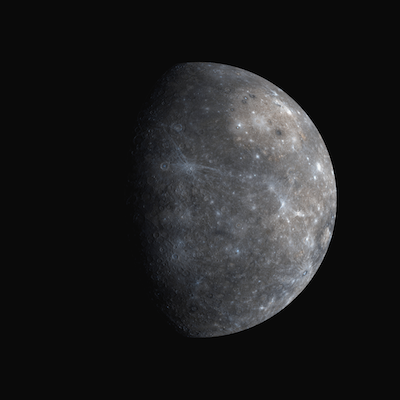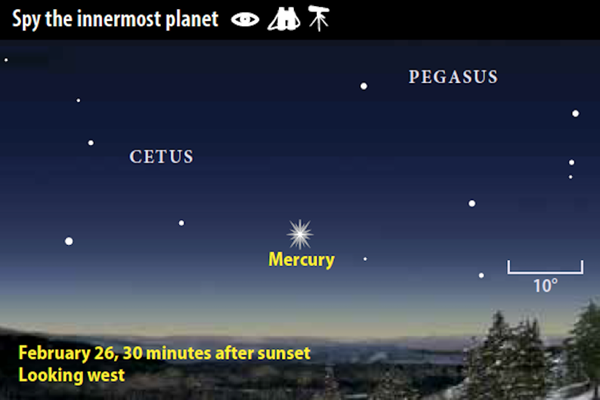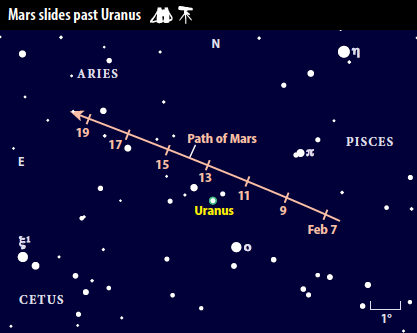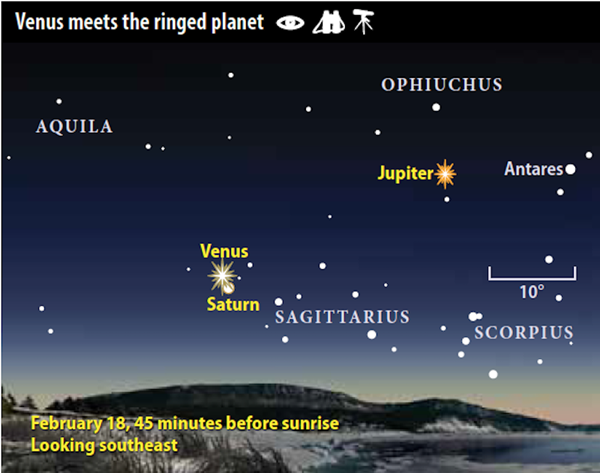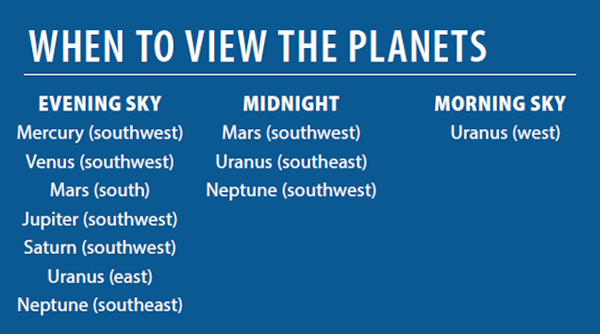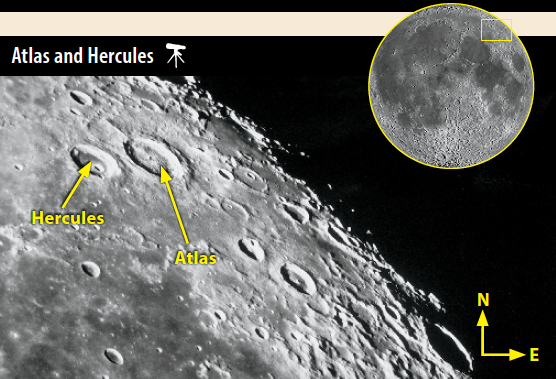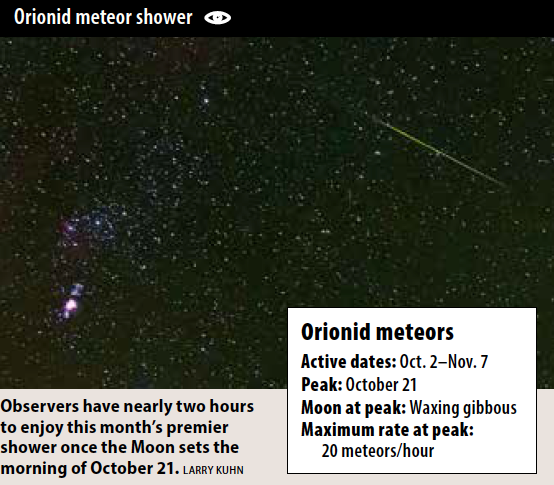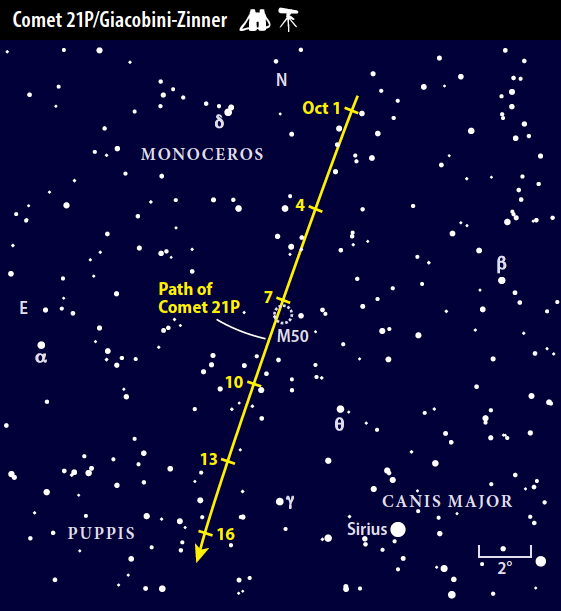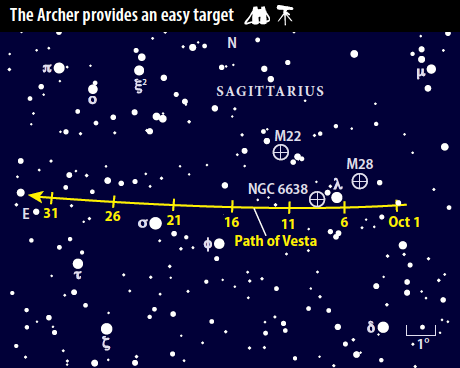The other three planets occupy the morning sky. With the late sunrises at this time of year, it shouldn’t be too hard to get up before dawn and enjoy Jupiter, Venus, and Saturn. The waning crescent Moon adds a lovely touch when it joins these worlds February 27 and 28.
We’ll begin our tour in evening twilight in mid-February. That’s when Mercury bursts on the scene. On the 15th, the innermost planet shines at magnitude –1.1 and stands 5° high in the west-southwest a half-hour after sunset.
Mercury climbs higher with each passing day, at least until the 26th when it reaches greatest elongation. It then lies 18° east of the Sun and stands 11° above the western horizon 30 minutes after sundown. The planet shines at magnitude –0.5 and appears conspicuous in the twilight.
In sync with Mercury’s improving visibility, the views through a telescope grow better as February progresses. On the 15th, the disk spans 5.6″ and appears nearly full. The planet’s diameter swells to 7.2″ at greatest elongation, when the Sun illuminates half of its Earth-facing hemisphere.
Unfortunately, by the time Mercury becomes prominent, Neptune has disappeared in the twilight. The outermost planet remains a tempting target in early February, however. It then lies nearly 15° high in the west-southwest as twilight fades to darkness. Neptune glows at magnitude 8.0, so you’ll need binoculars or a telescope to spot it.
That’s about as long as you’ll be able to follow Neptune. It disappears in twilight during February’s second week, sadly just before it meets Mercury. The two planets pass like ships in the night, coming within 1° of each other on the 18th.
Mars remains a notable evening presence all month. It begins February among the background stars of Pisces, but its eastward motion carries it into Aries on the evening of the 12th. Although the Red Planet fades from magnitude 0.9 to 1.2 during the month, it easily bests the stars in these two constellations. Its closest rival, magnitude 2.0 Hamal (Alpha [α] Arietis), stands 10° due north of the ruddy world on the 20th.
Despite its prominence, Mars proves disappointing through a telescope. It shows a featureless disk that spans 6″ in early February and just 5″ at month’s end.
Uranus also crosses from Pisces to Aries in February (on the evening of the 5th). The distant planet moves more slowly than Mars, however, and the Red Planet sweeps by around midmonth. On the 1st, Uranus lies 7° east-northeast of Mars. With the ice giant world shining at magnitude 5.8, observers with sharp eyes might spot Uranus with their naked eyes from a dark-sky site. Binoculars easily show the fainter planet’s glow.
The gap between the two narrows by more than 0.5° per day. On the 10th, just 1.5° separate the two. That same evening, a crescent Moon passes 6° southeast (to the left) of Mars. The two planets appear closest February 12, when Uranus stands 1.0° south-southeast of Mars. The following evening, Uranus lies 1.1° due south of Mars.
Binoculars or a telescope at low power nicely shows off the planets’ colors. While Mars displays its characteristic orange-red hue, Uranus presents a distinct blue-green color. Higher powers reveal Uranus’ 3.5″-diameter disk.
Jupiter resides in the southern part of Ophiuchus. This sprawling constellation’s brightest star, 2nd-magnitude Rasalhague (Alpha Ophiuchi) lies 35° north of the giant world. Still, it offers little competition: Magnitude –2.0 Jupiter shines 40 times brighter. The waning crescent Moon passes 2° north of the planet in a dramatic predawn conjunction February 27.
A telescopic view of Jupiter rarely fails to impress. The planet appears sharper as it climbs farther above the turbulent air near the horizon. Wait until twilight is about to break and then continue observing for another half-hour or so — the brightening sky helps reduce the glare. Jupiter’s apparent diameter grows from 34″ to 36″ during February, and even small scopes show major features in the gas giant’s cloud tops. Look for a pair of parallel dark belts, one of either side of a brighter zone that coincides with the planet’s equator.
You’ll also see Jupiter’s four largest and brightest moons: Io, Europa, Ganymede, and Callisto. If you see fewer, it means one or more of them are passing in front of or behind the planet’s disk. Watch the morning of February 6 to see Io and its shadow transit Jupiter. The inner moon’s shadow first touches the planet’s cloud tops at 5:45 a.m. EST followed by Io itself just over an hour later. Both are set against the North Equatorial Belt and take more than two hours to cross the disk. Throughout the morning hours, you can find outermost Callisto due north of Jupiter.
Venus is the next planet to rise, at least in early February. The inner planet clears the horizon some 30 minutes after Jupiter. Venus spends February against the backdrop of Sagittarius. It starts the month near the Archer’s western border with Ophiuchus and ends the month near its eastern border with Capricornus. In between, Venus passes near some of the Milky Way’s finest deep-sky objects.
Grab your binoculars February 4, when you can find the Trifid Nebula (M20) 2° due south of the planet and the Lagoon Nebula (M8) 1.5° farther south. On February 10 and 11, open star cluster M25 lies 2° north of Venus while globular star cluster M22 stands 3° south of the planet. All three fit nicely in the field of 7×50 binoculars.
Following this stunning conjunction, Venus moves eastward around 1° per day into the more barren reaches of Sagittarius. It wraps up February 11° east of Saturn and 2.5° north-northwest of globular cluster M75. The waning crescent Moon then stands midway between Jupiter and Saturn with Venus to their lower left. The four bright solar system objects appear strung across the predawn sky like beads on a necklace.
Unlike Venus, Saturn barely budges against the background stars, remaining slightly south of Sagittarius’ Teaspoon asterism. The ringed planet does rise much earlier as February progresses, however. On the 1st, it comes up as twilight starts to paint the sky around 5:30 a.m. local time. By the 28th, it rises at 4 a.m. and stands 10° high in the southeast as twilight commences.
With Venus and Saturn at low altitudes, views through a telescope are less than ideal. Venus shows a 19″-diameter disk that appears 62 percent lit February 1. By the end of the month, the planet’s disk measures 16″ across and the Sun illuminates 72 percent of it. If you grab a quick view of Saturn in late February, you’ll see a 16″-diameter disk surrounded by a ring system that spans 35″ and tilts 24° to our line of sight.
While Venus reigns as the night sky’s brightest planet, Sirius rules the stellar universe. But it may relinquish its crown briefly for a few lucky observers February 18/19. On that night, the 17th-magnitude asteroid 4388 Jurgenstock passes directly in front of the brilliant star. Sirius will dim significantly — if not disappear — for 1.8 seconds.
The event can be seen along a narrow path that stretches from near Cabo San Lucas, Mexico, to Winnipeg, Canada. (In the United States, the track crosses New Mexico, Colorado, Nebraska, and the Dakotas.) It occurs around 11:30 p.m. CST (10:30 p.m. MST). The track and time depend on the asteroid’s exact position, which won’t be known until a week or so before. Visit www.asteroidoccultation.com for the latest predictions.
What might you see from the center line? Astronomers estimate that Sirius spans 0.006″ and the asteroid 0.005″. If accurate, this means Sirius will dim significantly but not disappear. But slight errors in those measurements could result in Sirius vanishing. In either case, it’s an event you won’t want to miss.
On the evening of February 11, observers across North America are placed perfectly to watch a few points of light on the Moon evolve into a prominent letter X. Although it’s just a chance alignment of light and shadow as the Sun rises over some crater walls, it’s fun to see because it tickles our pattern-recognition fancy.
If you live on the East Coast, you’ll want to start viewing soon after sunset. Focus on a spot almost halfway between the equator and the south pole. Use the twin craters Aliacensis and Werner as guides to the Lunar X, which lies just to their northwest. In the image at right, the X is just beginning to show. If you take webcam clips every 5 to 10 minutes, you can create a time-lapse movie of the X emerging, peaking, and disappearing all in one evening.
Of course, the waxing crescent Moon features dozens of spectacular craters. Simply scan along the terminator — the dividing line between light and dark — and enjoy the view.
To observe meteors at their best, you need a dark sky. Fainter meteors disappear under the glow from the Moon or from artificial lighting. Although February doesn’t feature any major meteor shower, you can still see about a half-dozen so-called sporadic meteors per hour. These random streaks of light represent the fiery demise in Earth’s atmosphere of dusty debris from long-dead comets. This detritus fills the inner solar system, particularly along the plane of the ecliptic where the major planets orbit.
Another signature of these dust grains appears on February evenings. Sunlight reflecting off the particles creates a distinct glow visible to the naked eye in the west after darkness falls. This “zodiacal light” forms a cone-shaped radiance similar in brightness to the Milky Way. It shows up best on late-winter evenings because the ecliptic then makes a steep angle to the western horizon after sunset.
To see the zodiacal light, view from a dark site on an evening when the Moon is out of the early evening sky — from February 21 to March 7 this year. Look for the ethereal glow just after the last vestiges of twilight have faded away. Mars makes a good reference to the light’s direction because it also lies on the ecliptic.
As Comet 46P/Wirtanen enters the evening of its winter apparition, the ball of frozen dust and ice recedes from Earth and dims noticeably. This periodic comet drops into the inner solar system every 5.4 years before looping out to Jupiter’s orbit. That 0.4 decimal means that once Wirtanen lines up for a good apparition, like the one we’ve experienced these past few months, the timing won’t repeat for another five trips, or 27 years from now.
Optimists predict the comet will glow at 7th magnitude in early February, making it a decent binocular object under a dark sky and a nice subject through 4-inch or larger telescopes. Pessimists have it a couple of magnitudes fainter, which would mean you’ll need a 6-inch scope to see detail.
The good news is that Wirtanen will be easy to find in the northeast on February evenings. Use magnitude 3.2 Theta (θ) Ursae Majoris, which lies midway up the Great Bear’s front leg, as your guide. While you’re in the area, stop by the 9th-magnitude spiral galaxy NGC 2841. Compare the comet and galaxy at medium to high power. The galaxy’s brightness falls off abruptly on all sides, but Wirtanen should show a well-defined flank where the solar wind pushes the comet’s ejected gas away.
Your best Moon-free observing window comes during February’s first week. Although the Moon will be gone again during the month’s final week, Wirtanen should appear smaller then and perhaps two magnitudes fainter.
Scientists number asteroids in the order they were discovered. As you might guess, observers tend to find brighter objects before fainter ones, so most bright asteroids have low numbers. That makes this month’s target, 532 Herculina, particularly noteworthy. It peaks at magnitude 8.9 during February’s first two weeks. Among higher-numbered asteroids, only a few near-Earth objects ever surpass it. You can nab Herculina through binoculars under a country sky or with a 3-inch telescope from the suburbs.
The asteroid begins February in Leo, north of the Lion’s Sickle asterism, and appears high in the east at midevening. Herculina’s motion carries it into northern Cancer by month’s end, when it lies a few degrees south of 3rd-magnitude Alpha (α) Lyncis. The sparse star fields in this region should make it easy to identify which starlike dot is the asteroid. You can even see it move within an hour when it pairs up with slightly fainter stars on the 9th and 14th.
Herculina has a high number simply out of bad luck. Because its orbit inclines modestly to the solar system’s plane, it often reaches peak visibility outside of what were the major search areas for asteroids as the field was ramping up in the latter half of the 19th century. German astronomer Max Wolf discovered Herculina photographically in April 1904, one of more than 200 minor planets he captured. It typically ranks as the brightest asteroid discovered in the 20th century.

